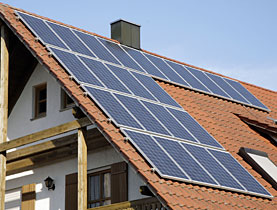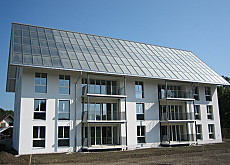Shining the spotlight on solar power

As oil prices rise, electricity produced from the sun's rays is becoming an economically attractive option – also in Switzerland.
But its uptake in the country is still relatively low. Solar Days, held across Switzerland, is aiming to raise awareness of this alternative source of power.
Solar Days, held on Friday and Saturday, is made up of more than 160 events, such as house open days.
“People can go along and talk to the owner and see for themselves how the solar installation works. This is much more convincing than getting the information from someone who wants to sell you an installation,” said David Stickelberger, secretary general of Swissolar, the solar power professionals association, which is coordinating the days.
Solar Days, invented by Austria, has been held annually in Switzerland since 2004. This year marks the first ever European Solar Days, with nine other countries participating.
Stickelberger says there is currently an increased enthusiasm for sun power because of high energy prices. “We still have among the lowest energy heating oil prices in Europe… but now it’s really getting relevant and people want to do something about it,” he told swissinfo.
Another reason, says Stickelberger, is that the Swiss do not like to be dependent on other countries, especially “the Gulf Region with all the crises going on there”.
“Solar energy gives people a good feeling of producing their own energy on their own roof,” he said.
Solar energy thermal applications – such as black roof panels – can be used for generating heat for hot water and heating. Most cantons offer subsidies for the – often costly – installation.
Photovoltaic technology
Photovoltaics refers to the direct conversion of sunlight into electricity. “Solar electricity from photovoltaics is about 0.05 per cent of total energy consumption, so it’s nearly nothing,” Urs Wolfer, responsible for solar energy at the Federal Energy Office, told swissinfo.
“But if you look at its potential, when you use the best surfaces of buildings and put photovoltaic panels on them, you can produce up to 25 per cent of Swiss electricity consumption,” he said
Switzerland is aiming to increase renewable energy production by 5,400 GW/h (gigawatt hour) – ten per cent of current electricity consumption – by 2030. Renewable sources now account for 58 per cent of overall production, with 97 per cent from hydropower.
One promotion measure, started on May 1 and due to come into force in 2009, is compensatory feed-in remuneration for electricity produced from renewable energies and fed into the Swiss electricity grid. The annual budget for this is SFr320 million ($303 million).
“We have had a big success since we started this law, on the first days we had more than 3,000 people interested,” said Wolfer.
However, Swissolar says the law does not provide enough money for photovoltaics – five per cent of the budget – so won’t cover all interested parties. It is calling for an overhaul.
Overshadowed
Despite moves towards green energies, Switzerland, after being at the forefront of solar power 15 years ago, is now lagging behind its European counterparts in this area.
This, Wolfer says, is because the government has not pushed solar energy as electricity has not been a problem.
Neighbouring Austria is a leader in photovoltaics – with ten times more solar collectors per inhabitant than in Switzerland – because it voted against nuclear power 30 years ago, explained Wolfer.
But there is still one burning question – is there enough sun in Switzerland for solar energy?
“We have a lot of sun, the average in Switzerland is somewhere between 1,000-1,500 KW/h (kilowatt hour) per square metre and year, and in the Sahara it’s just 2,500, so there’s not really a big difference between a not so sunny place like Switzerland and the sunniest place in the world,” Stickelberger told swissinfo.
“We have to develop technologies to use this sun even better than now and Switzerland is in quite a good position because we have a very developed research network with good links to industry.”
swissinfo, Isobel Leybold-Johnson
The Solar Days are taking place Switzerland-wide on May 16-17. 163 events are planned.
This year’s event forms part of the very first European Solar Days. Participating countries in 2008 are Austria, Belgium, France, Germany, Italy, the Netherlands, Portugal, Spain, Slovenia, Switzerland, with single events also taking place in Denmark, Norway and Britain.
The European event is coordinated by the European Solar Thermal Industry Federation (ESTIF) in close cooperation with European Photovoltaic Industry Association (EPIA), and is supported by 25 organisations at national and European level.
Solar thermal application: solar radiation is absorbed on a black surface and used to heat water. It can be stored and used as needed.
Photovoltaics: this is the direct conversion of solar energy to electricity. This can be stored in batteries. An electronic inverter can be used to convert the energy into normal electricity in households and this can be distributed to the electricity network.
According to Swissolar, in 2007 there were around 55,000 solar installations in Switzerland. Around 6,500 photovoltaic collectors were sold last year, up from 2,500 in 2006, in preparation for the May 1 measure.
Experts say the potential for solar energy is enormous. But the high cost of its collection, conversion, and storage still limits its exploitation.

In compliance with the JTI standards
More: SWI swissinfo.ch certified by the Journalism Trust Initiative












You can find an overview of ongoing debates with our journalists here . Please join us!
If you want to start a conversation about a topic raised in this article or want to report factual errors, email us at english@swissinfo.ch.